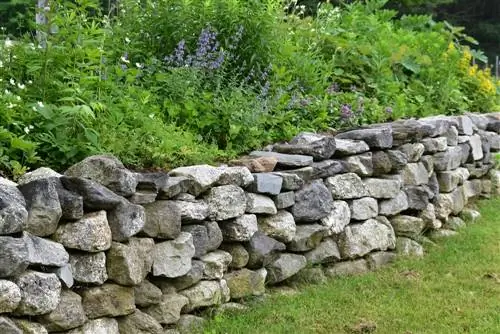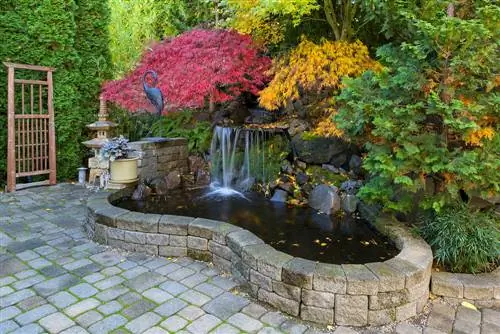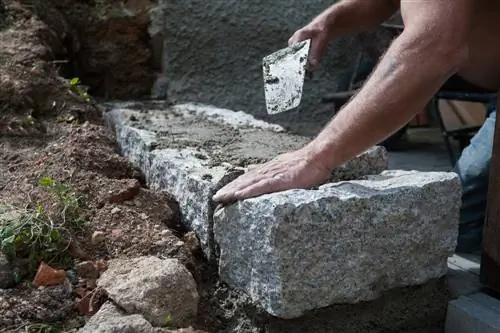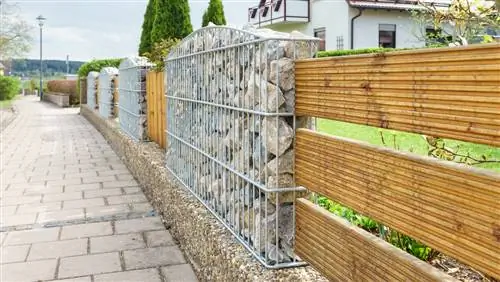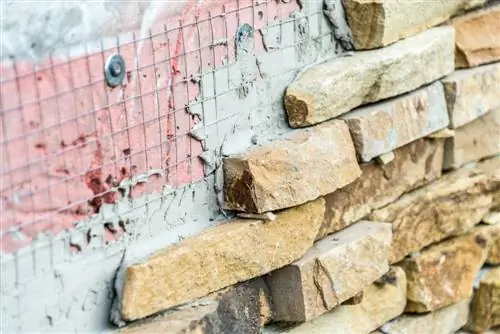- Author admin [email protected].
- Public 2023-12-16 16:46.
- Last modified 2025-06-01 06:02.
They are becoming more and more trendy because natural stone walls have a wild character and loosen up the overall picture. The design possibilities are almost endless. But when building, some aspects must be taken into account so that the construct is stable and weatherproof.
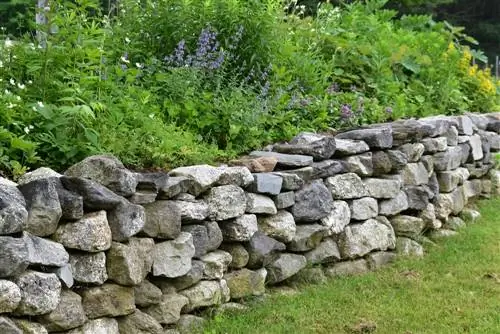
What you need to consider before construction
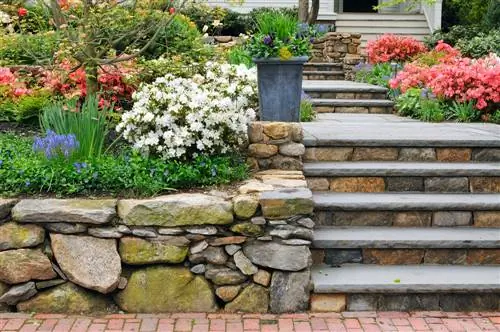
Natural stone walls are often used to support slopes
Natural stone walls set accents and provide a habitat for animals and plants. At the same time, they take on a variety of tasks. In principle, it is not difficult to build a wall from natural materials. However, some considerations are necessary in advance.
An overview of the possibilities:
- Garden: Wall for heat-loving and drought-resistant plants
- Slope: one meter high slope fortification made of shell limestone
- Raised bed: Bed border made of granite or sandstone
- Edge of property: enclosing natural stone wall, free-standing as a privacy screen
- Terrace: Natural stone wall on the slope to compensate for different earth levels
- Interior: Exposed sandstone brickwork in the living room
With or without foundation?
Walls are generally more stable with a foundation, which prevents the wall from sinking into the ground and thus from falling apart. Therefore, you should not build a wall without a foundation. But with dry stone walls you can forego a foundation in frost-free soil layers. To ensure that the individual stones do not settle too much, a sufficiently stable surface made of gravel and gravel is sufficient. Minor settlements are harmless with this natural construction method.
Excursus
Types of dry stone walls
These buildings are the oldest form of stone construction, because multifunctional objects are created by piling up loose stones. They were built free-standing as pasture boundaries or as supports to form agriculturally usable terraces in steep hillside landscapes. The third form of dry stone wall is the lining wall, which is reminiscent of a retaining wall. It takes on the functions of cladding or protection against erosion.
- Friesenwall: Stacking of round boulders that are compacted with turf soil
- Cyclops Wall: irregular joint pattern, without horizontal joints, typical for the Mediterranean region
- Tanca Wall: stack of loose field stones, typical for the Balearic Islands
- Premuiceva staza: hiking trail with irregular dry stone wall principle
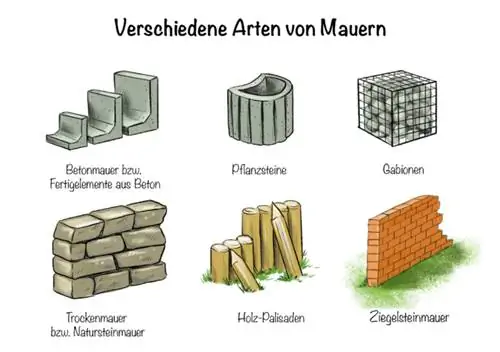
Freestanding or supporting?
Supporting garden walls secure embankments that are at risk from landslides. They compensate for different height levels and are relatively wide and massive because they have to withstand a lot of pressure. The construction of these variants is significantly more complex compared to a free-standing natural stone wall. While open-air buildings simply stack stones on top of each other, the so-called embankment walls must be backfilled with frost-proof gravel. They require a seal on the inside to prevent seepage water from the ground from penetrating.
Drywall or mortar wall?
A dry stone wall is the more natural variant, because reading stones are usually stacked loosely on top of each other. In order for this construct to be stable even without binders, three aspects regarding the material must be met:
- only use stones with a high weight
- these require a rough and uneven surface
- stones with an irregular shape that wedge into each other are ideal
In mortar masonry, the stones are connected using mortar to create a stable structure. Cut natural stones whose dimensions match each other are better suited for this purpose. Irregularities caused by building walls can be compensated for by grouting.
| Drywall | Mortar wall | |
|---|---|---|
| suitable materials | Sandstone, limestone, granite | almost all natural stones that have been cut to size |
| Time expenditure | high, because stones have to be stacked precisely | relatively fast |
| Purpose | Habitat for heat-loving species, for planting | Slope attachment, seat or stairs |
| unsuitable as | Seat or steps | Plant object |
| wall head | meaningless, rainwater seeps into joints | should be shaped accordingly to ensure water drainage |
Materials and prices
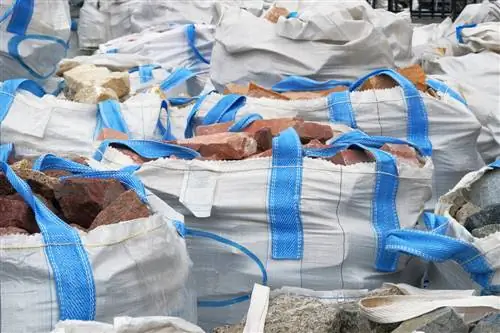
The selection of natural stones is large - so is the price range
The costs incurred can only be roughly estimated as they vary greatly from person to person. In principle, it is cheaper if you get natural stone directly from the quarry. Deliveries are expensive because additional costs have to be paid for transport. The following table gives you an overview of the material costs for common stones.
| Art | Prices per ton | Coloring and texture | |
|---|---|---|---|
| Granite | Hardstone | approx. 80 to 150 euros | equal or unequal grained crystals |
| Bas alt | Hardstone | around 200 to 700 euros | anthracite to black, rarely with fragments |
| Muschelkalk | Softstone | approx. 100 to 200 euros | brownish to grayish deposits |
| Sandstone | Softstone | around 50 to 100 euros | warm orange and brown tones, Mediterranean |
| Limestone | Softstone | around 120 euros | fossil inclusions, porous surface |
Additional costs
In addition to the material costs for the natural stone wall, you have to factor in additional costs. These concern tools and building materials for the foundation. Here you should expect costs between 100 and 150 euros per square meter, although this price can be higher depending on the preferred material or costs for skilled workers, work equipment and tools.
Grouting - with what?
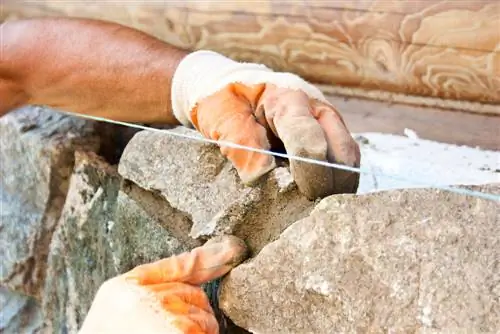
A natural stone wall can, but does not have to be grouted
Mortar is necessary for a concrete natural stone wall. Soft stones such as sandstone or limestone require grout that is softer than the rock. It is important to have a permeable structure so that water can seep through and the sandstone does not weather. A grain size of around two millimeters is ideal. With this mortar you have to expect costs of around three euros per kilogram. Hard rock can be grouted with a cement-based mortar mix. Here the price is around 60 cents per kilogram.
Excursus
Grouting with trass cement
Trass refers to natural sedimentary rocks or igneous stones that are finely ground and used as a binding agent. Such mortar mixtures have waterproof properties and are used where the material is exposed to high levels of moisture, such as supporting embankment walls. Efflorescence, which occurs with conventional cement, is avoided. Trass cement is characterized by flexibility, which remains even after drying. This means there is no risk of cracks forming in the joints. In addition, the natural stones do not discolor.
Comparison: natural stone or concrete stone?
In addition to natural stone, there are now also variants made of concrete that are modeled on natural wall stones. Concrete stone is a cheaper option compared to natural stone. You can expect costs from around 40 euros per square meter upwards per square meter.
This speaks for concrete block:
- Optics: smooth sanded, wood or natural stone grain
- Properties: robust, durable, resilient and frost-proof
- Special features: available with or without sealing
Building a natural stone wall
If you want to build a drywall, you do not need any materials for gluing or bonding such as cement and concrete. Here the stones are simply stacked loosely. The situation is different with a concrete wall with natural stones. If you would like to build this variant yourself, you will have to expect more work.
Build foundation
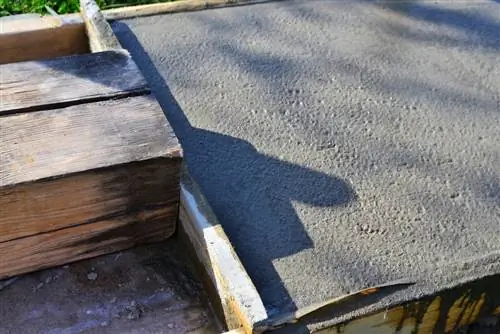
A good foundation ensures a long life for the natural stone wall
Every garden wall needs a foundation because this gives the structure stability. If you are planning a wall up to half a meter high or a dry stone wall, a layer of gravel 40 centimeters deep is sufficient. Mortarized walls or building projects that are intended to be taller will have optimal stability with a concrete foundation that is at least 80 centimeters deep. This depth is necessary so that the massive foundation is not blown up by frost in winter.
How to build a concrete foundation:
- Define the course of the wall with wooden pegs and strings
- Dig a trench 20 centimeters wide along the guide
- Fill the trench 60 percent with frost-resistant gravel
- Constantly compact material
- Concrete the remaining 40 percent
- lay the first layer of stone while the mortar is still wet
Special feature: Concrete natural stone wall with slope
Many dry stone walls are filled with earth on the inside. With this variant, it makes sense that the concrete foundation slopes slightly inwards. This way the water can drain away better. If you only use natural materials such as gravel and gravel, you don't have to pay attention to the slope.
Building a free-standing natural stone wall - instructions
Making naturally shaped stones requires a bit of skill, as the uneven surface will quickly cause you to lose your way. To avoid tilting, you should build formwork out of boards. This allows two layers of natural stone to be stacked on top of each other. You then have to wait several days for the mortar to dry. The formwork is realigned with each work step. If you want your wall to be wider, you can fill the interior with a mixture of coarse gravel and lean concrete. Finally, use the most beautiful stones as a wall crown.
Grouting natural stone wall
Masonry objects are grouted to create an aesthetic finish. This is the case, for example, with bed borders and slope fastenings. You can also stabilize non-brick structures by pressing grout into the spaces between the bricks.
- Wet the wall well so that the joint compound does not set too quickly
- Pull the grout over the joints from bottom to top with a trowel
- Joint must be pressed evenly deep into the joints
- Work excess compound into the joints with a sponge
- after grout has set, rub joints to an even height

Dry laying of a plantable natural stone wall - placing stones
Formwork is also helpful with this variant so that you can align the stones correctly. Place the stones so that they fit together perfectly and wedge together. If you later want to plant the wall, fill the joints with loamy sand or nutrient-poor soil. The interior is filled with crushed stone or gravel and compacted. Finally, design the top of the wall with a layer of 20 centimeters of topsoil. You can later plant overhanging and creeping plants here.
Tip
You can also avoid using sand as a joint material if, for example, you are designing a dry stone wall without gravel filling. All you have to do is place the stones together precisely. Make sure that the wall tapers slightly towards the top.
Covering the natural stone wall
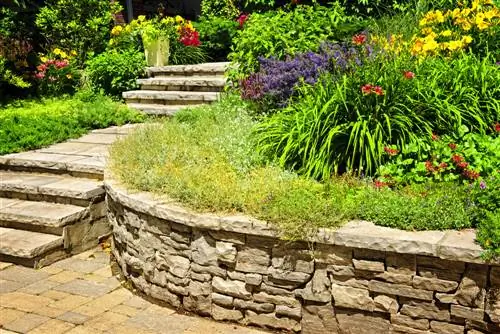
A natural stone wall looks best when it is covered naturally
Concrete walls that do not have an irregular wall crown must be protected from rainwater with a wall cover in accordance with DIN standard 1053. If you forego this construction measure, rainwater can penetrate and dampen the wall. After a few years, the stability of the wall would be at risk. This design is not required if your wall has a slope.
Shapes of covers:
- Easy installation for sheet metal covers
- Natural stone covers are also available
- Monk and nun bricks create Mediterranean character
Additional components
Natural stone walls can stand on their own or be embellished with various building elements. High privacy walls have a Mediterranean character thanks to an integrated window. A waterfall made of natural stones looks particularly natural. Fences and lighting elements are also possible. There are no limits to your imagination.
Attach fence to natural stone wall
If you want to subsequently build a fence on the wall, you will need post supports. These must be firmly connected to the wall so that the fence is stable. You can either attach the post bases with a dowel or glue them in place. To do this, you need to drill holes in the natural stone with a stone drill. For the adhesive variant, you need synthetic resin cement or special glue that hardens solidly and offers a long-term hold.
Integrate lighting
Lighting elements embedded in the masonry look particularly beautiful. For this you can use recessed floor spotlights that are cast in epoxy resin. The material is waterproof and protects the technology. If possible, you can also place artificial stones between the natural stones. These can be cut out or opened before building the wall so that you can use LEDs as you wish.
Tip
So that you can expand the lighting if necessary, you should grout artificial stone with silicone.
How to plant a natural stone wall
Plants beautify masonry walls that provide substrate for growth and have not been grouted or plastered. If the stones remain largely visible and are not completely overgrown, they create an aesthetic contrast. This habitat places extreme conditions on plant growth, so not every species is suitable for planting. The selection of plants that grow on and on dry stone walls is huge despite the extreme conditions.
Important to note:
- don't plant too densely
- choose drought-resistant plants
- Creeping plants cope with the limited supply of soil
Leave space in the joints

The joints can also be beautifully planted
You can put plants in the gaps directly during construction, or integrate them after the drywall has been completed. In the latter case, you must ensure that the joints are sufficiently wide during construction. Most plants thrive when the gap is about two fingers wide. There are species that also do well with less space. If the joint is deep enough, two to three plants have enough space to grow in just a few centimeters.
Planting instructions:
- divide large pot balls, shorten roots if necessary
- Place species as deep as possible in the joints so that they can anchor themselves
- Fill gaps with substrate
- water well, but proceed carefully
Wall plants
The south side of the wall heats up during the day due to solar radiation and stores this heat until it is released again at night. The stones act like a natural heater and provide an optimal habitat for Mediterranean herbs such as lavender, rosemary and thyme.
Plants for the sun:
- upright perennials: bluebells, St. John's wort and carnation
- carpet-forming species: blue cushion and carpet phlox
- overhanging plants: gypsophila, cinnamon and stonecrop
Moisture-loving species thrive in shady areas. There is enough space here for mosses and ferns such as spotted fern. Moss saxifrage, Waldsteinia, toadflax and goose cress or the early-flowering larkspur provide colorful accents. These plants thrive ideally in partial shade.
Plants for the wall crown
Evergreen plants and upholstery perennials are ideal for the plateau on the masonry. Mix upright perennials such as the cushion bluebell and woolly ziest with creeping or trailing species. Andean cushions, Delosperma species or silver sheaves are ideal. These store moisture under their dense cushions and in this way compensate for strong fluctuations that are favored by changing temperatures.
Numerous plants are specialists that are adapted to the extreme location of dry stone walls.
Frequently asked questions
How can I clean a natural stone wall?
Cleaning depends on the degree of contamination and the material used. Sandstone and limestone are sensitive and should be cleaned gently with a soft sponge and water. You can soak heavy dirt with a mixture of water and soap. If mosses, algae and lichens have already spread, you can scrape them off with a hardwood stick or carefully with a spatula. For hard rocks you can use a harder brush. Joints should be cared for annually with a high-pressure cleaner to prevent moss from settling.
What do I have to consider when renovating?
Before any renovation, there must be a thorough cleaning. This involves testing one after the other to determine which process is a suitable method for the existing material. Dry cleaning does not remove any material, which is important for soft stones. Harder dirt usually has to be removed using wet or blasting methods.
In order to prevent further contamination, a coating with fine wax crystals is recommended. If you want to restore joints, you need to scrape the old material out of the gaps as best you can. Special restoration mortar is suitable for correcting larger defects.
Does it make sense to plaster the natural stone wall?
Plaster can make natural stones that are getting old disappear. Time leaves its mark, especially on external walls, so that moss grows or the stones slowly weather. It's easier than plastering to cover your garden wall. There are various weatherproof options made from natural stone or plastic.
Which joint path is the right one?
You should avoid cross joints as they do not withstand the pressure of layered stones or the earth behind them. Staggered gaps are better, as they loosen up the overall picture at the same time. These can be designed regularly or irregularly. In the uniform design, all stones on a level have the same height. More variety is created by using stones with different shapes and dimensions.

